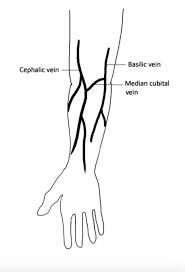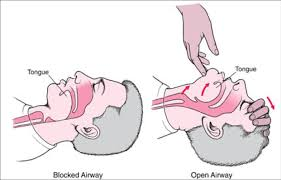According to the CLSI standard, a phlebotomist must attempt to locate which of the following veins on both arms before considering other veins?
Median cubital vein
Basilic vein
Cephalic vein
Veins on the underside of the wrist
The Correct Answer is A
Choice A Reason:
The median cubital vein is often the first choice for venipuncture due to its size and accessibility. It is located in the antecubital fossa and is usually well anchored by surrounding tissues, which makes it less likely to roll during needle insertion. This vein is also less painful for patients when punctured due to its location and the type of surrounding tissue.
Choice B Reason:
The basilic vein is another option for venipuncture, but it is not typically the first choice. It is located on the medial aspect (inner side) of the arm and is more prone to rolling and injury because it is not as well anchored as the median cubital vein. Additionally, the basilic vein is located near nerves and arteries, which increases the risk of complications during venipuncture.
Choice C Reason:
The cephalic vein runs along the lateral aspect (outer side) of the arm and can be used for venipuncture. However, it is often more difficult to locate and has a tendency to roll, which can make venipuncture more challenging. It is usually considered after the median cubital vein.
Choice D Reason:
Veins on the underside of the wrist should generally be avoided for routine venipuncture because they are often smaller, can be more painful due to the proximity to nerves and tendons, and have a higher risk of complications. These veins are considered only when other sites are not available or are unsuitable for venipuncture.

Nursing Test Bank
Naxlex Comprehensive Predictor Exams
Related Questions
Correct Answer is D
Explanation
Choice A Reason:
Keeping the patient as upright as possible is not recommended in cases of shock. When a patient is in shock, it is important to lay them down and elevate their legs slightly, unless this position causes pain or further injury. This position helps improve blood flow to the brain.
Choice B Reason:
Providing a cooling blanket is not a standard first aid measure for shock due to a medication reaction. A cooling blanket may be used in cases of hyperthermia or heatstroke to reduce body temperature, but not typically for shock, which requires maintaining normal body temperature and preventing chilling.
Choice C Reason:
Administering oral fluids to a patient in shock is not advisable. During shock, a patient may have an impaired swallowing reflex or be unconscious, increasing the risk of aspiration. It is best to avoid giving anything by mouth until medical personnel arrive.
Choice D Reason:
Maintaining an open airway is crucial for a patient in shock. Ensuring that the airway is clear allows the patient to breathe effectively, which is essential for delivering oxygen to the tissues and organs. If the patient is unconscious or has an altered level of consciousness, the phlebotomist should check for breathing and begin CPR if necessary.

Correct Answer is D
Explanation
Choice A reason:
The high pressure in the arterial system is not a factor in the filling of blood collection tubes during venipuncture. Arterial blood is not typically collected using evacuated tubes; these are used for venous blood collection, where the pressure is lower.
Choice B reason:
While the venous system does have pressure that aids in blood flow, it is not the high pressure that causes blood collection tubes to fill. Venous pressure is relatively low compared to arterial pressure, and on its own, it is not sufficient to fill the vacuum tubes used in venipuncture.
Choice C reason:
The positive pressure created by the tourniquet can help engorge the veins, making them easier to access, but it does not directly cause the blood collection tubes to fill. The tourniquet's role is to assist in vein visualization and palpation rather than in the filling of the tube.
Choice D reason:
The negative pressure within the tube is the correct factor that causes blood collection tubes to fill during venipuncture. When the needle punctures the patient's vein and then the tube stopper, the vacuum in the tube pulls blood into it until the vacuum is exhausted or the tube is filled. This is why it is essential not to allow the tube contents to contact the stopper, as backflow into the venous system can cause adverse reactions.
Whether you are a student looking to ace your exams or a practicing nurse seeking to enhance your expertise , our nursing education contents will empower you with the confidence and competence to make a difference in the lives of patients and become a respected leader in the healthcare field.
Visit Naxlex, invest in your future and unlock endless possibilities with our unparalleled nursing education contents today
Report Wrong Answer on the Current Question
Do you disagree with the answer? If yes, what is your expected answer? Explain.
Kindly be descriptive with the issue you are facing.
